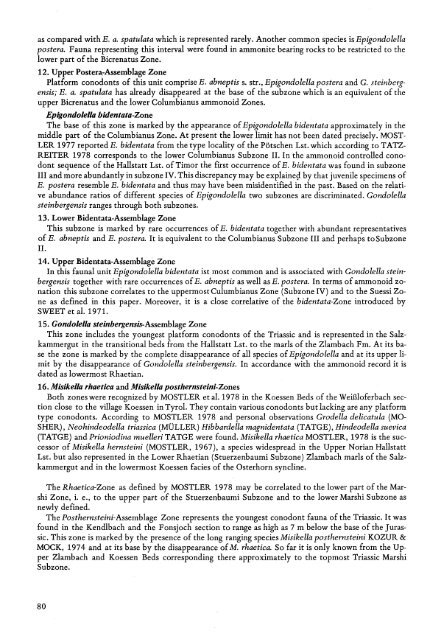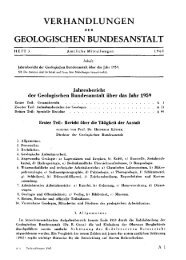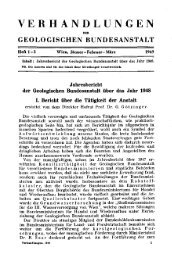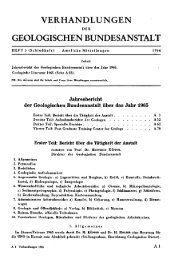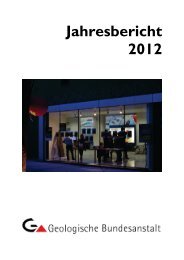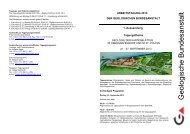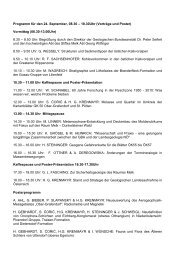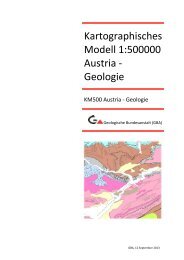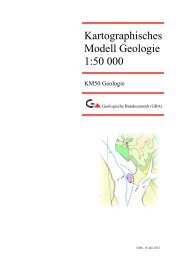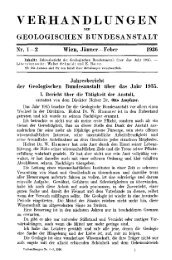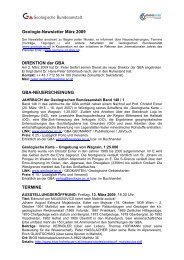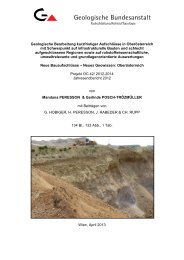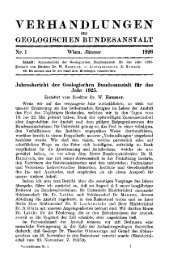Field Trip B TRIASSIC CONODONT LOCALITIES OF THE ...
Field Trip B TRIASSIC CONODONT LOCALITIES OF THE ...
Field Trip B TRIASSIC CONODONT LOCALITIES OF THE ...
You also want an ePaper? Increase the reach of your titles
YUMPU automatically turns print PDFs into web optimized ePapers that Google loves.
as compared with-E. a. spatulata which is represented rarely. Another common species is Epigondolella<br />
postera. Fauna representing this interval were found in ammonite bearing rocks to be restricted to the<br />
lower part of the Bicrenatus Zone.<br />
12. Upper Postera-Assemblage Zone<br />
Platform conodonts of this unit comprise E. abneptis s. str., Epigondolella postera and G. steinbergensis;<br />
E. a. spatulata has already disappeared at the base of the subzone which is an equivalent of the<br />
upper Bicrenatus and the lower Columbianus ammonoid Zones.<br />
Epigondolella bidentata-Zone<br />
The base of this zone is marked by the appearance of Epigondolella bidentata approximately in the<br />
middle part of the Columbianus Zone. At present the lower limit has not been dated precisely. MOST-<br />
LER 1977 reported E. bidentata from the type locality of the Pötschen Lst. which according to TATZ-<br />
REITER 1978 corresponds to the lower Columbianus Subzone II. In the ammonoid controlled conodont<br />
sequence of the Hallstatt Lst. of Timor the first occurrence of E. bidentata was found in subzone<br />
III and more abundantly in subzone IV. This discrepancy may be explained by that juvenile specimens of<br />
E. postera resemble E. bidentata and thus may have been misidentified in the past. Based on the relative<br />
abundance ratios of different species of Epigondolella two subzones are discriminated. Gondolella<br />
steinbergensis ranges through both subzones.<br />
13. Lower Bidentata-Assemblage Zone<br />
This subzone is marked by rare occurrences of E. bidentata together with abundant representatives<br />
of E. abneptis and E. postera. It is equivalent to the Columbianus Subzone III and perhaps to Subzone<br />
II.<br />
14. Upper Bidentata-Assemblage Zone<br />
In this faunal unit Epigondolella bidentata ist most common and is associated with Gondolella steinbergensis<br />
together with rare occurrences of E. abneptis as well asE. postera. In terms of ammonoid zonation<br />
this subzone correlates to the uppermost Culumbianus Zone (Subzone IV) and to the Suessi Zone<br />
as defined in this paper. Moreover, it is a close correlative of the bidentata-Zone introduced by<br />
SWEET et al. 1971.<br />
15. Gondolella steinbergensis-Assemblage Zone<br />
This zone includes the youngest platform conodonts of the Triassic and is represented in the Salzkammergut<br />
in the transitional beds from the Hallstatt Lst. to the marls of the Zlambach Fm. At its base<br />
the zone is marked by the complete disappearance of all species of Epigondolella and at its upper limit<br />
by the disappearance of Gondolella steinbergensis. In accordance with the ammonoid record it is<br />
dated as lowermost Rhaetian.<br />
16. Misikella rhaetica and Misikella posthernsteini-Zones<br />
Both zones were recognized by MOSTLER et al. 1978 in the Koessen Beds of the Weißloferbach section<br />
close to the village Koessen in Tyrol. They contain various conodonts but lacking are any platform<br />
type conodonts. According to MOSTLER 1978 and personal observations Grodella delicatula (MO-<br />
SHER), Neohindeodella triassica (MÜLLER) Hibbardella magnidentata (TATGE), Hindeodella suevica<br />
(TATGE) and Prioniodina muelleri TATGE were found. Misikella rhaetica MOSTLER, 1978 is the successor<br />
of Misikella hernsteini (MOSTLER, 1967), a species widespread in the Upper Norian Hallstatt<br />
Lst. but also represented in the Lower Rhaetian (Stuerzenbaumi Subzone) Zlambach marls of the Salzkammergut<br />
and in the lowermost Koessen facies of the Osterhorn syncline.<br />
The Rhaetica-Zone as defined by MOSTLER 1978 may be correlated to the lower part of the Marshi<br />
Zone, i. e., to the upper part of the Stuerzenbaumi Subzone and to the lower Marshi Subzone as<br />
newly defined.<br />
The Pos^erasremi-Assemblage Zone represents the youngest conodont fauna of the Triassic. It was<br />
found in the Kendlbach and the Fonsjoch section to range as high as 7 m below the base of the Jurassic.<br />
This zone is marked by the presence of the long ranging species Misikella posthernsteini KOZUR &<br />
MOCK, 1974 and at its base by the disappearance of M. rhaetica. So far it is only known from the Upper<br />
Zlambach and Koessen Beds corresponding there approximately to the topmost Triassic Marshi<br />
Subzone.<br />
80


